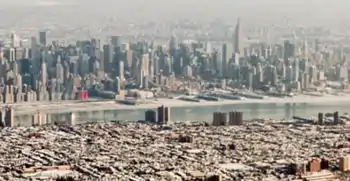Core city
In urban planning, a core city, metropolitan core, or central city, is the largest or most important city of a metropolitan area. A core city is surrounded by smaller satellite cities, towns, and suburbs. A central city is usually the first settlement established in an urban region before the outlying districts came into existence, later in history. Central cities often form the regional downtowns of metro areas. The term is used mainly in US context, although since the 1970s it has also become relatively common in Canada and, to a lesser extent, Europe and Australia.[1][2][3][4]

The skyline of Manhattan as seen from Hudson County, New Jersey in March 2014. New York City is the core city of New York metropolitan area.
Examples
Metropolitan areas with one core city
The followings are the core city of the five largest metropolitan areas in the world.
| Metropolitan area | Core city | Country | Metropolitan population | |
|---|---|---|---|---|
| Name | Location | |||
| Greater Tokyo Area (Kantō region) |
Tokyo | 35°41′23″N 139°41′32″E | 37,274,000[5] | |
| Jakarta metropolitan area (Jabodetabekpunjur) |
Jakarta | 6°10′30″S 106°49′43″E | 33,430,285[6] | |
| Delhi metropolitan area (Central National Capital Region) |
Delhi | 28°36′36″N 77°13′48″E | 29,000,000[7] | |
| Seoul Capital Area (Sudogwon region) |
Seoul | 37°34′N 126°58′E | 25,514,000[8] | |
| Mumbai Metropolitan Region | Mumbai | 18°58′30″N 72°49′33″E | 24,400,000[9] | |
Metropolitan areas with more than one core city
| Metropolitan area | Core cities | Country | Metropolitan population | |
|---|---|---|---|---|
| Name | Location | |||
| Dallas–Fort Worth metroplex | Dallas | 32°46′45″N 96°48′32″W | 7,470,158[10] | |
| Fort Worth | 32°45′N 97°20′W | |||
| Rhine-Ruhr metropolitan region | Essen | 51°27′3″N 7°0′47″E | 1,555,985[11] | |
| Düsseldorf | 51°14′N 6°47′E | |||
| Islamabad–Rawalpindi metropolitan area | Islamabad | 33°41′35″N 73°03′50″E | 4,500,000[12] | |
| Rawalpindi | 33°36′N 73°02′E | |||
See also
References
- Caves, R. W. (2004). Encyclopedia of the City. Routledge. p. 72.
- "Central city definition and meaning | Collins English Dictionary".
- "Definition of CENTRAL CITY". www.merriam-webster.com.
- "Principal Cities 2012 Demographic Economic Patterns General Demographics". proximityone.com.
- "Table 2.10 Population of Three Major Metropolitan Areas" (PDF). Statistics Bureau of Japan. p. 21. Retrieved 26 November 2013.
- "Jabodetabekpunjur". perkotaan.bpiw.pu.go.id. Ministry of Public Works and People's Housing. Archived from the original on 6 February 2020. Retrieved 22 February 2020.
- Sharma, Shantanu Nandan (February 17, 2019). "Delhi could be the world's most populous city by 2028. But is it really prepared?" – via The Economic Times.
- ???? : ???? ???? (in Korean). Ministry of Government Administration and Home Affairs. Archived from the original on 3 March 2011. Retrieved 4 April 2015.
- https://portal.mcgm.gov.in/irj/go/km/docs/documents/MCGM%20Department%20List/Roads%20and%20Traffic/Docs/CMP%20for%20Greater%20Mumbai/Executive%20Summary/Executive%20Summary.pdf
- "Dallas - Fort Worth - Arlington (Metropolitan Statistical Area, Metropolitan Areas, USA) - Population Statistics, Charts, Map and Location". www.citypopulation.de.
- "Metropolitan Area Populations". Eurostat. 18 June 2019. Retrieved 4 December 2019.
- "Box-1: Rawalpindi–Islamabad Metrobus Project" (PDF). Ministry of Finance and Revenue. 30 June 2014. p. 197. Retrieved 11 March 2020.
Further reading
- OECD (2020). Urban Policy Reviews: Enhancing Productivity in UK Core Cities. OECD Publishing. ISBN 9789264882140.
- Parkinson, Michael (2004). Competitive European Cities: Where Do the Core Cities Stand?. Office of the Deputy Prime Minister. ISBN 9781851126903.
External links
This article is issued from Wikipedia. The text is licensed under Creative Commons - Attribution - Sharealike. Additional terms may apply for the media files.